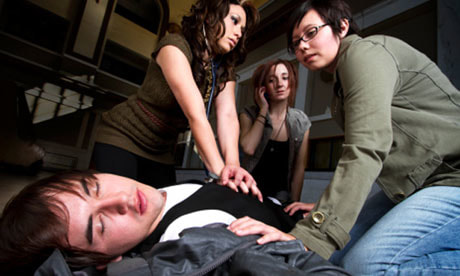What is an AED anyway?
And why is it so important?
|
An AED (Automated External Defibrillator) is a usually described as a portable device that checks the heart rhythm and can send an electric shock to the heart to try to restore a normal rhythm. AEDs are used to treat sudden cardiac arrest (SCA). SCA is a condition in which the heart suddenly and unexpectedly stops beating.
What people don't always realise is, the electric shock that it sends through the pads actually stops the heart beating. The heart has its own electrical system and so by "shocking" it and stopping the heart, it will hopefully restart in the correct beating rhythm. It's a bit like the IT guy saying "Have you tried turning it off and turning it back on again?" When you're presented with a sudden cardiac arrest you aren't going to know exactly what's happening. All you know is that you've got an unconscious, unresponsive patient in front of you. Don't for get your "DRSABCD"! |
So you've got CPR underway, you've got help coming and someone is getting an AED. So why is an AED so important? Won't CPR do the trick?
CPR is just part of the equation. CPR done well will keep that oxygenated blood circulating to that most important of organs - the brain. You're doing the mechanical part with CPR, the squeezing of the heart muscle. Just remember, a well trained, fit, strong person doing good quality CPR will only get that blood circulating to a rate equivalent to about 33% of what the heart can do when it's beating properly. (Get trained on how to do it properly!)
What you can't know for sure is what rhythm the patients heart is in - there are 4 rhythms of cardiac arrest, and only 2 of those are shockable. This is why the AED is so important.
There's only one way to correct those 2 rhythms - a shock with an AED.
CPR is just part of the equation. CPR done well will keep that oxygenated blood circulating to that most important of organs - the brain. You're doing the mechanical part with CPR, the squeezing of the heart muscle. Just remember, a well trained, fit, strong person doing good quality CPR will only get that blood circulating to a rate equivalent to about 33% of what the heart can do when it's beating properly. (Get trained on how to do it properly!)
What you can't know for sure is what rhythm the patients heart is in - there are 4 rhythms of cardiac arrest, and only 2 of those are shockable. This is why the AED is so important.
There's only one way to correct those 2 rhythms - a shock with an AED.
Does an AED make a real difference?
Warning! Statistics follow :
The St John Out of Hospital Cardiac Arrest Report shows the following :
- More than 2,000 New Zealanders will suffer a cardiac arrest this year, outside of a hospital environment - that's more than 5 a day
- 60% of them will be given CPR from a bystander but
- Only 6% of them will also have an AED used
- When an AED is used by a bystander before Emergency Services arrive, the patient's chance of survival to hospital is dramatically improved - from 13% to 56%
- It's really simple - AEDs save lives, we need to have access to them.
- You can see the report here : OHCA report
Should we get an AED for our workplace?Too right! Here's why ...Look around your workplace. How much has been invested into Fire Extinguishers, sprinkler systems, alarms, fire escapes, ladders etc? How much time and effort has been put into fire related Health and Safety action plans, staff training, risk assessments, fire drills ...
And it's all sensible to do that, but now ask yourself this ... How much has been invested into dealing with a Sudden Cardiac Arrest? Why do I ask that ...? |
You and the people at your workplace are 96 times more likely to die at work from a Sudden Cardiac Arrest than die in a fire (figures from Cardiac Science, USA - respect!)
Is your workplace prepared? Do you have an AED (Automated External Defibrillator) on site?
Is your workplace prepared? Do you have an AED (Automated External Defibrillator) on site?
Talk to us about getting an AED for your business premises. We can supply ( and install ) one at your place of work at a very good rate - just ask for a quote!
Any profits made are put back in to the Charity to go towards installing AEDs in public areas and training people on CPR and AED use.
Any profits made are put back in to the Charity to go towards installing AEDs in public areas and training people on CPR and AED use.


